Taco Crawls And Crypt Visits! A Topographical Tour Of Oakland
by Ben Choi
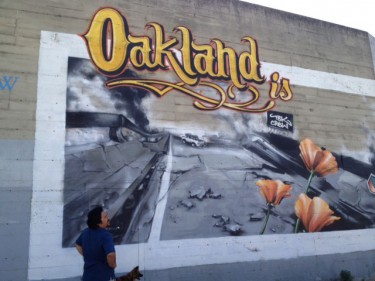
This post is brought to you by HomeAway. Discover the world’s largest selection of vacation home rentals with HomeAway.com. Let’s stay together.
I like cities with a little grit and texture, with character. And just like with people, it’s the ups and downs that build character, not sunshine and lollipops. Oakland is a city of highs and lows. And it knows it. Lately, some things have been looking up. There’s been some smart growth downtown, and Oakland managed a spot on The New York Times’ list of “places to go in 2012.” But unlike some of its more glamorous neighbors, Oakland still feels grounded and inclusive, even amid the gentrification and corporatization that comes with urban growth. There are hipsters, but they don’t all look alike. There are one-percenters, but they feel kinda guilty about it. There’s a Whole Foods, but it’s full of people of color! You get the sense that Oakland is trying incredibly hard not to be spoiled by its success. There’s nothing wrong with doing better in the world, as long as you don’t forget who you are. The city’s rich history, and the essential character of its neighborhoods, can still be sensed in the face of Oakland’s emerging, hard-won prosperity — and in the ongoing struggle to keep it real on the way to Pilates class.
In keeping with the idea of highs and lows making up the texture of city life, here’s a little topographical tour of some of the neighborhoods and attractions of Oakland. Please don’t take this as a definitive list; mostly it’s intended as a way to get you out into different parts of the city where I know you’ll find lots of great sights, sounds and situations. May your experience of Oakland be pleasantly uneven.
WEST OAKLAND, elev. 11 ft.
West Oakland comes off as a barbed, rugged part of town. It’s so industrial, there are trucks and trains and cranes and chain-link fences with concertina wire. Middle Harbor Shoreline Park is right in the middle of this industrial zone, but it’s a bit of a departure from this gritty, hard-hat image. Though giant container cranes loom above each end of the park, this 38-acre recreational area serves as part of the Eastbay Regional Park system, and its once-contaminated shoreline is in the process of being restored as a tidal wetland and wildlife habitat. Shoreline Park also has some truly impressive views of San Francisco from across the bay. Definitely one of my favorite places to catch the sunset.
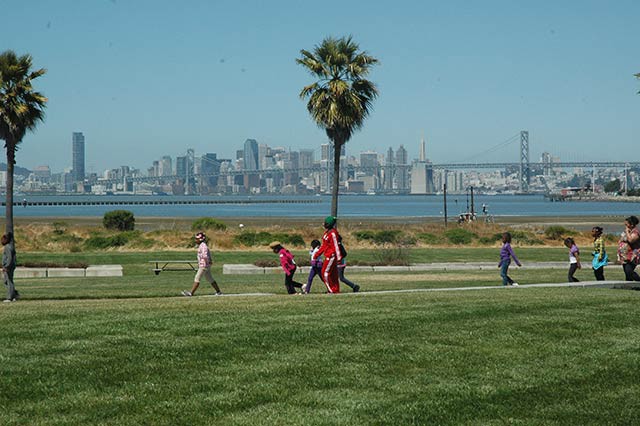
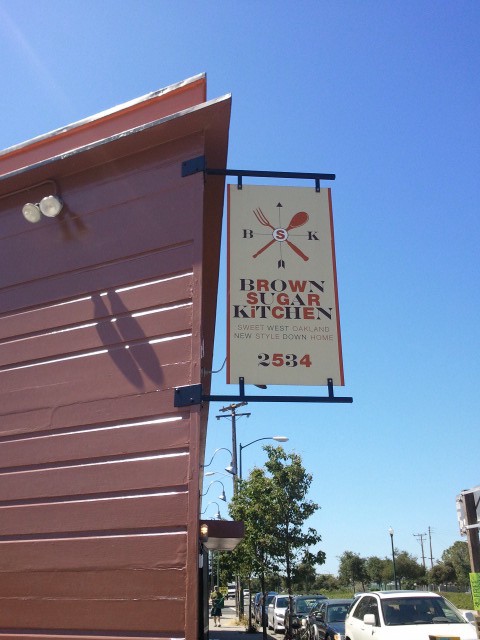
If that fresh San Francisco Bay air has gotten you a little peckish, drop in on the folks at Brown Sugar Kitchen. Chef/owner Tanya Holland serves up ‘new soul’ cooking that stresses local and seasonal ingredients, but doesn’t skimp on the comfort part of comfort food. The atmosphere is casual and friendly. It basically feels like the cleanest, most popular truck-stop diner you’ve ever seen. Make sure to try the cornmeal waffles with brown sugar butter and apple cider syrup. They’re crispy on the outside, but strangely airy and light on the inside inside. Well, maybe they aren’t actually that light.
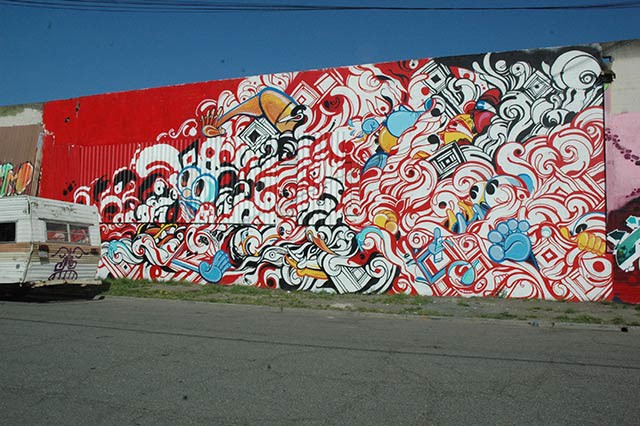
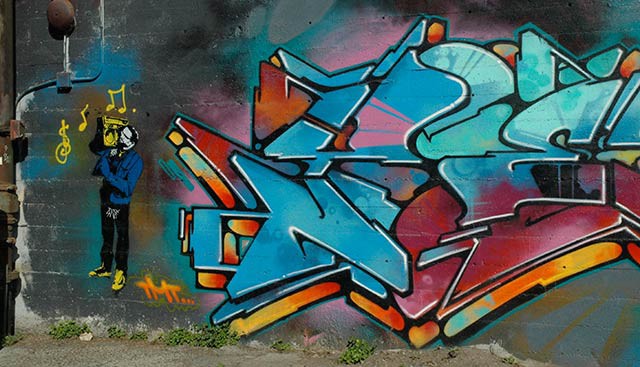
West Oakland is also known as the home to some of the city’s finest graffiti art. You find good examples in all kinds of places around the neighborhood, but the corner of 26th and Willow is a good place to start. There are about a half-dozen top-quality graffiti murals right in that area. Some of these definitely bring high art right down to street level.
UPTOWN OAKLAND, elev. 20–35 ft.
In recent years, the Uptown neighborhood has become Oakland’s hands-down favorite night spot. This kind of widespread popularity would normally irk me, and I’d eventually find something about Uptown Oakland upon which to wax righteously indignant. Unfortunately, in this case I cannot. Not only do I genuinely like going out in Uptown Oakland, I suspect I enjoy it for the very same reasons everyone else does. Whenever you’re out in Uptown you feel a sense of ownership and community. You’re not just out on the town, you’re out on our town.
The successful renovation and reopening of the Fox Theatre a few years ago was a nostalgic victory for Oakland. There was the feeling that the good old days were being restored. The Fox has been thriving, but not in such an old-fashioned way. The Fox has been booking alternative rock and indie bands and even the dirgy stylings of Mastodon. The Fox Theatre has established itself as a timelessly classy, yet current venue to see live music.
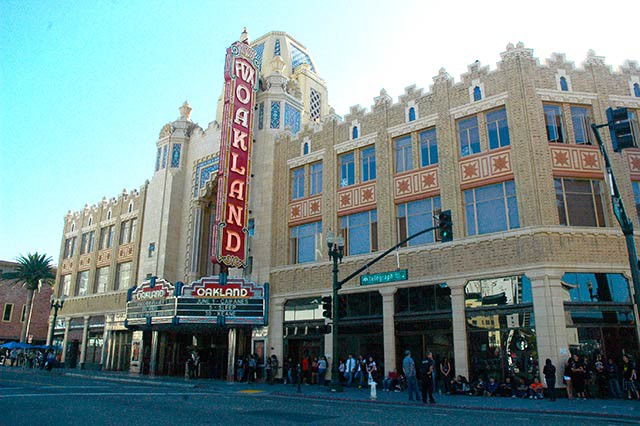
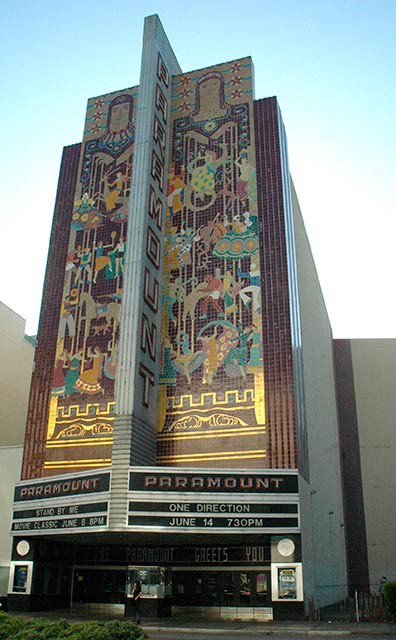
The Paramount Theatre, on the other hand, revels in its anachronistic, Art Deco splendor. Its Summer Classic Movie Series runs on Friday nights well into September, making it a natural for date night, or just as a relaxing, low-key way to start the weekend.
Speaking of relaxing, the atmosphere at Pican is awash with Southern elegance and style. Enjoy a fine sippin’ bourbon at the piano bar & lounge or enjoy a leisurely sit-down meal with friends on the outdoor patio. Or if you’d prefer an artsy, postmodern setting with your cocktails, get to happy hour at Mua just up the block. Industrial decor, tasty small plates: it’s a perfect way to start an evening out.
And if you’re planning to be in Oakland on the first Friday of the month, make sure not to miss the Oakland Art Murmur. The open galleries, street food and open-air activities exemplify the city’s spirit of creativity and community.
JACK LONDON SQUARE, elev. 12 ft.
This frowsy waterfront district is cleaning up nicely, but it still retains some of its roguish charm. Spending the day around the dilapidated wholesaler buildings just a couple of blocks from the waterfront feels a little like playing hooky around the docks. That said, things have gone a little upscale. If you enjoy starting the day with a superior cup of coffee, drop by Blue Bottle Coffee. You won’t be disappointed. You may, however, be a little intimidated by how seriously the staff and customers take their coffee. There’s even a glass-walled ‘cupping’ room where people with rimless eyeglasses slurp and aerate their black coffee quite loudly. It’s like a Scientology Center for the caffeinated.
Bay Area Bikes — Rentals is located right on the waterfront, and you can rent a variety of bikes by the hour, day or week. You can ride along the Bay Trail or pedal along on a street-level tour of Oakland’s many neighborhoods.
When you get back from your ride, check out Everett and Jones, Oakland’s preeminent barbecue destination. The pork ribs are highly recommended and the barbecue sauce is delectable.
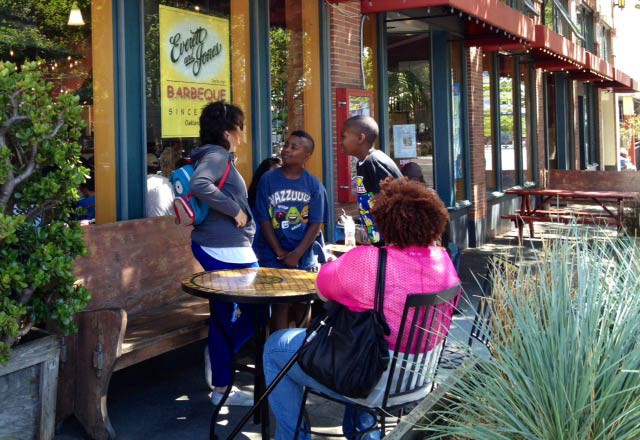
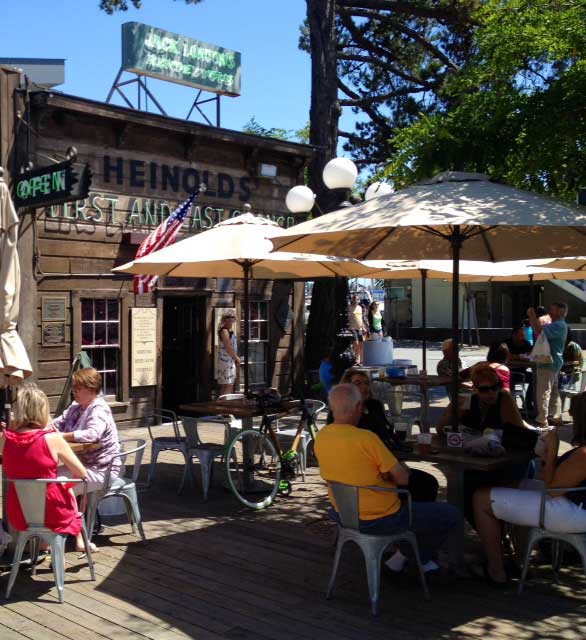
Heinold’s First and Last Chance Saloon was one of the teenaged Jack London’s favorite haunts, and it has changed little from the days young Jack sat at the bar writing short stories. Today as then, Heinold’s is full of characters worthy of tipping a glass with. Soak in the old-timey atmosphere, but watch your step. The floor of the First and Last Chance Saloon is permanently warped and dipped from structural damage that resulted from the 1906 earthquake.
TEMESCAL, elev. 114 ft.
The Temescal neighborhood boasts an eclectic selection of restaurants: gourmet pizza, tapas, Eritrean, Korean, Mexican, etc. Here’s a few of my standby favorites; I think you’ll like them. But there are so many good places to eat in Temescal, all within a short walking distance from each other, right on Telegraph, that you should feel free to rely on gut instinct if you are so moved.
Bakesale Betty. It’s travesty that a restaurant that’s open only 12 hours a week can be this successful. I have to admit, though, that the fried chicken sandwich is just that good. You may have to wait in line with dozens of hipsters, but they’re a pretty good-natured lot. And when it’s your turn… the ginger cookie is also spectacular.
I don’t think I had ever tried Burmese food before I first experienced a meal at Burma Superstar. It seemed to me that the food was, at the same time, both exotic and strangely familiar. Chinese and subcontinental influences melded into a kind of Asian Fusion style. I was hooked. Be sure to try the fermented tea leaf salad, I seem to have to order it every time I go to Burma Superstar.
There are quite a few Korean restaurants in the Temescal neighborhood, and most of them are pretty good. Almost every time I’m in the area, however, I go to Sahn Maru. This place specializes in homestyle Korean, and I find the array of menu options to be kind of quirky, and impressively varied. You can’t go wrong with the soft tofu stew and spicy pork barbecue combo, but if you’re feeling adventurous, try the fish roe soup, or the pork neckbone and potato stew. This place serves pretty large portions, and all meals come with the traditional, banchan, or small accompanying dishes. Enjoy the food of my people.
MOUNTAIN VIEW CEMETERY/CHAPEL OF THE CHIMES, elev. 174–250 ft.
I may be a little odd, but my favorite two places in Oakland are a cemetery and a crematorium. Not for morbid reasons. It’s just that the Mountain View Cemetery and the nearby Chapel of the Chimes may be the most aesthetically harmonious places in the city.

The cemetery dates back to the 1860s and was designed by Frederick Law Olmsted, the landscape architect behind New York’s Central Park. Mountain View Cemetery presents the visitor with a vision of nature that is romantic and expansive , but not so colossal that it dwarfs the human figure. Similarly, it’s a perfect place to take in ear-popping hilltop views of the Oakland skyline and the San Francisco Bay without feeling one has really left the city. Above all it’s a wonderful place to go for walk on a nice day, a little time-out, not an excursion.
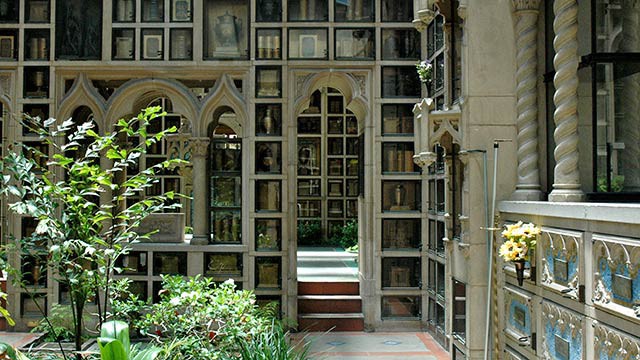
The Chapel of the Chimes reflects a more internal, tranquil sense of well-being. The Julia Morgan design is suggestive of a library at Cordoba, or a gothic priory. Bathed in natural light and featuring exquisite, but minimalist ornamentation, the walls are just the right dimension, just the right color.
FRUITVALE, elev. 55 ft .
The International Blvd. taco crawl is, for us who live in the East Bay, a mythic quest over which nobody can triumph. The idea of consuming one taco, or burrito, or huarache, or torta from each of the taco trucks or taquerias along a umpteen-block stretch of 14th street no longer appeals to me as it once did. I’m not even sure if it’s actually physically possible. Here are my picks for a totally reasonable four-item taco crawl.

La Costa. This is one of the real traditional places to get Mexican food in Oakland. Any of the Ceviches will serve as the perfect antojito for a four-course crawl.
La Torta Loca #1. Okay, this place is actually inside a laundromat, don’t let that spook you. The tinga huarache is the standout here. And it’s a stable enough food platform that you can eat as you walk to Taqueria Sinaloa, great place for just plain tacos. I’m rather fond of their cabeza and al pastor varieties.
Now the last course is the most substantial. El Ojo de Agua is now at a new location, International Blvd and Derby. Be warned, you’re going to get a torta here, and it’ll be quite large. I recommend washing it down with a liquado smoothie.
Next stop, maybe a nap.
Sponsored posts are purely editorial content that we are pleased to have presented by a participating sponsor, advertisers do not produce the content.
Previously: A Minnesota Nice Guide To The Twin Cities and Lobstah And Crafts! A Summertime Guide To Portland (The Real One, In Maine)
Ben Choi, who writes this site’s Search For The Next Sriracha column, lives in the Bay Area with his wife Erica and dog Spock.
Book Good
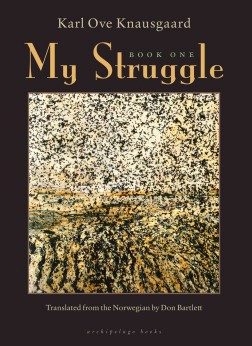
I just finished Karl Ove Knausgaard’s My Struggle over the weekend and I am still trying to process it, but I can say that it is one of the more affecting and resonant books I’ve read in quite some time. The first of six volumes, My Struggle — called A Death in the Family in Britain and To Die in Germany — is “at the center of a debate about literary ethics” and the whole fiction vs. memoir thing, but what’s so striking about the book is the terrifying emotional frankness with which Knausgaard confronts his own history. Literary critic Toril Moi describes it as “expressing embarrassment and shame in a male mode,” and I suppose that’s pretty close to it. As a white guy who basically runs on a steady diet of embarrassment and shame it certainly spoke to me. Apparently being a teenager in Norway is about the same as being a teenager in suburban America, except there’s more fish-eating and waiting around for buses. Anyway, it’s probably not for everyone, but if you think it’s the kind of thing that will appeal to you don’t get discouraged by the debate or the Norwayness; focus on the sad humiliations of being human.
Moon-Hater Conflicted
Jamie Dimon: I don’t see JPMorgan being wiped out unless the earth is hit by the moon.
— CNBC (@CNBC) June 19, 2012
Don’t make me root for the moon, Dimon. Just don’t.
The East is Drunk: Hammered and Sickled in China
by Abram Dylan
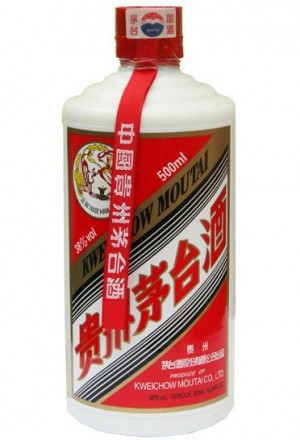
Part of a two-week series on the pull of bad influences in our lives and in the culture.
When a British businessman died of alcohol poisoning in a Chongqing hotel earlier this year, it seemed completely unremarkable to anyone who had worked in China. Boozing — heavily and to great personal detriment — is such a common practice in China that an old China Hand could easily have had a run-in with counterfeit, contaminated alcohol. Or he just overdid it.
Of course, that was no run-of-the-mill British businessman and it wasn’t alcohol that poisoned him. But it was probably the commonality of “baijiu culture” accidents that led his assassins to choose a method that would look like it was. It’s not at all uncommon for Chinese government officials or businessmen to literally drink themselves to death in an attempt to show off to peers and superiors.
The pressure to drink, and drink a lot, is so great that even Mormon Jon Huntsman admitted he tippled while serving as U.S. Ambassador to China.
In 2009, a Guangdong police officer who passed away after drinking to excess at an official event was said to have “died in the line of duty.” He received the official designation of “martyr,” which greatly increased the compensation his family received. The officer’s death came just after another official, ironically with Wuhan’s water resources bureau, also succumbed to too much drink.
While not the official cause of death, the Guangdong cop and the Wuhan cadre died of inadequate jiuliang (酒量), which literally means “booze capacity,” or in common usage, “ability to hold one’s drink.” In modern China, showing off one’s jiuliang, often on numerous nights (or afternoons) a week, is part of doing business or being important. Like the eighth rule of Fight Club, if it’s your first time, you have to drink.
In fact, you pretty much have to drink no matter how many times it’s been. That’s the whole point of what has been branded “ganbei culture.” Ganbei (干杯) is the Chinese toast which directly translates as “dry glass,” and means something between “cheers” and “chug!” And if you hear it, well, at least you’re still conscious.
Luckily, the cup you’re about to chug is probably a small shot glass. Unluckily, if it’s small, it means it is probably filled with baijiu (白酒), the catch-all name for one of a number of Chinese spirits that westerners most commonly compare to kerosene or jet fuel.
While getting plowed has a long, colorful, poetic history in China — one of drunken poet laureate Li Bai’s most famous works is about waking with a hangover and immediately hitting the bottle — Ganbei culture and its importance in business is a more modern phenomenon.
Chengdu resident Derek Sandhaus, an American editor and author of Tales of Old Peking and Tales of Old Hong Kong, observed in an interview, “Over-consumption of baijiu seems to be more of a modern phenomenon. People discussing baijiu consumption in the dynastic times often note the absence of public drunkenness in China as opposed to what they would commonly see elsewhere.” While many westerners avoid baijiu at all costs, Sandhaus recently started a blog (300 Shots at Greatness) to chronicle his journey as a baijiu enthusiast. As he wrote, “my first positive encounter with baijiu happened about 75 shots in.”
Though, in true China Hand form, it’s rumored that “Huntsman would drink the clear alcohol once and then switch to water, hoping no one noticed after the first round.”
As mentioned, one illustration of just how much pressure there is for foreigners to show face can be seen in Jon Huntsman’s decision to forego his Mormon beliefs to drink baijiu at official banquets while an ambassador to China in 2009 to 2011. Though, in true China Hand form, it’s rumored that “Huntsman would drink the clear alcohol once and then switch to water, hoping no one noticed after the first round.”
And there’s no better indicator of just how important boozing is at official levels than China’s stock market. The highest dividend in the history of China’s A Shares stock market was paid to investors in 2012 by baijiu maker Kweichow Moutai.
And when Premier Wen Jiabao issued an edict that government funds could no longer be used to pay for luxury alcohol, top baijiu brands like Moutai and Wuliangye saw share prices fall over 6 percent. When Henan Province slapped a ban on cadres drinking during lunch, local baijiu sales were said to have fallen by a third. Baijiu manufacturers challenged the ban. Meanwhile, the same year that the policeman was martyred, the capital of Yunnan Province, Kunming, instituted a ban on forcing officials to drink. A week into the ban it was reported that “New ganbei ban yet to nab cases.”
In the city of Xinyang, one estimate put spending on official boozing at $2 million per month. Beijing University School of Government Professor Li Chengyan estimates that officials spend $73 billion each year on banquets, much of which goes to baijiu. No wonder that big names like LVMH (Louis Vuitton Moet Hennessy) and Diageo are getting into the baijiu business. Yes, there is also a “Jackie Chan baijiu.”
***
One’s jiuliang is not static: the more one joins in ganbei culture, the better one does in ganbei culture, and the more one is required to participate in ganbei culture. It’s an upward spiral. Provided, of course, one doesn’t die a martyr in the process.
A “redrawn battle line” is how Sandhaus himself describes his jiuliang: “For a while my record stood at twelve shots, then it jumped to 21 after a very sloppy lunch with the folks at Kweichow Moutai. Later on, I split a bottle of baijiu with the manager of Fengyong Erguotou in Beijing and I thought that was about as much as I could handle. But then I drank one and a quarter bottles with the manager of Shuijingfang.”
The absurdity of ganbei culture is represented by (unconfirmed) reports from China expats of rich and especially important Chinese business officials who have begun hiring surrogates specifically to do their dangerous binge drinking for them. They’re outsourcing their jiuliang.
Sandhaus suspects that some of ganbei culture can be explained by men drinking little in college and then hitting “that embarrassing keg-standing, shot-gunning phase of their drinking lives much later.” Nonetheless, in modern China, being able to drink is, he said, “a relevant professional skill.” He continued, “If you’re going to work with someone, you are expected to go out to dinner with them. The senior or more important party is expected to act as host, part of which means providing alcohol and making sure your guest has drunk his or her fill. To refuse the kindness of your host, for whatever reason, can be seen as throwing a wrench in things and potentially disrupting the relationship. Thus if you really want to succeed in the Chinese business environment, you’re going to have to drink a lot of baijiu whether you like it or not.”
One cautionary tale comes from Adam Sherlip, the executive director of The Hockey Foundation who was hired to coach pro hockey in the northern city of Harbin. In a post for World Nomads, Sherlip wrote that his was an “amazing experience that contributed heavily to where my personal and professional life has progressed” but that it also “left me wondering how I could have prepared and behaved differently.” With no time to recover from the flight, Sherlip writes that “We… had a session on the ice, followed by drinking a fair portion of baijiu (Chinese liquor) and then going back on the ice.” As a pro athlete tip, he dryly added, “Drinking before and after hockey every day is not part of my normal routine.” Sherlip soon began passing on the baijiu, telling his hosts “no ganbei.” How did that work out for him? “As a result of my saying no, my nickname quickly became ‘No Ganbei.’” After his return to America, Sherlip reevaluated his experience thusly: “I could’ve just explained the value of maintaining a strict diet for hockey that excluded so much alcohol. It would’ve been a respectful way out, instead of just saying ‘no’ without explanation.”
The reasons for taking every offered shot are complex and many. The situation was best summed up by a 40-something head teacher last year when he told The Guardian, “If I drink, it doesn’t necessarily help me get promoted. But if I don’t, it’s less likely that I will be. So I must drink, even if it’s not pleasant at all,”
This reality is even the official party line. A few years ago, The China Daily, the state’s official English language newspaper, offered some advice to foreigners for success at a Chinese business banquet: “How to refuse a toast?” wondered the paper. “It’s impolite to refuse to drink when a host suggests a toast, as the refusal will make the host lose face, or not feel respected.” Oh, and also: “Sometimes&mash;for instance, being late or having made a mistake (jokingly), you may be ‘punished’ to drink three glasses of alcoholic beverage in succession to show you’re sincerely sorry. This ‘punish toast’ is, of course, just for fun.” Got that? Just for fun.
***
Many China expatriates weary of baijiu have developed their own ganbei culture subterfuges. One can surreptitiously cut red wine with water. Some replace a cup of baijiu with water. (The drinks look the same.) In a pinch, others substitute in Sprite (Just be careful as the carbonation bubbles are a giveaway, and getting caught probably results in a three-drink “punish toast.”) One American lawyer in Shanghai said she drinks her baijiu when called upon, but “[I] hold it in my mouth and immediately afterwards pretend I’m taking a sip of water or beer to wash it down, but really I’m spitting it back into the water or beer glass. So far, no one has noticed, or at least, not publicly called me on it.”
Another technique is to shift the focus to another drink. During an earlier stay in China, a colleague and I used to bring a bottle of Jack Daniels to meetings that we suspected would be extra wet. We had discovered that our Chinese counterparts found Jack Daniels too bitter. By insisting every baijiu shot be followed by one of Jack, we slowed the rounds down considerably. Not an ideal solution, but anything helps. A long-time resident of Beijing, John, said that since all booze is most commonly consumed from small shot glasses, “a good win is if you can get the party to switch to beer.” He added, “And if one is so lucky, be smart and go with a beer like Suntory with a lower than average alcohol content.” Beer is also less likely to be counterfeit.
A lot of expats may find themselves taking the “signs of alcoholism” questionnaire every week or wondering if that indigestion is really a failing liver, but Sandhaus said counterfeit drinks pose the “main health risk” because of the substandard ingredients used. When a Jiangsu auction house offered free inspections of baijiu bottles, it found that 30 percent of all those brought in were fakes. And that was a far lower percentage than others have found.
Then there are those who have decided that if something had to suffer, it would be their business prospects. Paul, a former college athlete who has been doing business in China for 20 years, said that, after a while, he found that he was drinking nearly every day, all the time. Strolling through a Shanghai park, he shook his head, shrugged, and said, “I just finally told everyone, ‘I don’t drink.’ I told my staff. Everyone. Eeeeeeeevvvvvryone. Under no circumstances will I drink.” So far, it’s working.
“Generally if you make it clear before the bottle gets cracked that you aren’t a drinker or you have some health reason which precludes you from drinking alcohol, the host will give you a face-saving out,” said Sandhaus. “I think you get into the most trouble when you start drinking with everyone else and then try to stop, because at that point you’ve already established yourself as a participant and to not return another’s toast could be seen as bad form.”
***
Obviously, a society that embraces ganbei culture poses particular hazards for those with existing alcohol issues.
Alcoholics Anonymous now has meetings in Beijing, Chengdu, Shanghai, Shenzhen, Kunming, Xiamen and Hong Kong, amongst other cities. It also offers online, Skype-based meetings. In Shanghai, some meetings are in the Sacred Heart of Jesus Catholic Church; others are in the basement of a “Donut King.”
Counterfeit drinks pose the “main health risk” because of the substandard ingredients used. When a Jiangsu auction house offered free inspections of baijiu bottles, it found that 30 percent of all those brought in were fakes.
As a matter of trivia, while AA-affiliated doctors were laying groundwork as early as 1995 in the country, ex-pats did not hold an official meeting until 2000. It was still illegal for Chinese nationals to participate until 2002. While it has no religious affiliation, AA was founded by Christians and makes use of Christian texts, and that association did not make official acceptance easy. As a result, the meetings attended by Chinese men and women were, and still are, based in hospitals. Yet, after an initial period where AA was viewed at a suspicious distance, the state is opening up to promote it. In 2010, within a span of two days, the China Daily ran two different stories casting AA in a very positive light.
While meetings are now held in many major cities, the organization still has few members. The meetings in Chengdu and Beijing attract, by various reports, a dozen or so. In 2010, the China Daily cited an AA source as saying report stating that 1,000 had attended at least one meeting. But AA keeps no rolls, and is not in any way centralized, and nobody today even seems sure where that figure came from.
With such a limited understanding of alcoholism, many expats, in locales strewn across China, face the stresses alone. A recovering alcoholic in an industrial city with only a small expat community said, “I immediately order peach juice or blueberry juice upon arrival with a client. I toast every ganbei with peach juice or blueberry juice or water.” In two years of this strategy, only once has he been asked why he does not drink.
Another expat who spent five years in Beijing and now lives outside Shanghai, said, “I always give the same answer and have never had any problem. I tell them the truth. I’m allergic to alcohol and can’t drink it.” That he found help through AA is only rarely mentioned.
He continued: “I’m personally always proud to say I don’t drink and Chinese people have always been respectful of my decision and refusal to drink alcohol. Besides, I always notice that when the people start getting really drunk they never notice the difference of whether I’m sober or drinking.” Furthermore, he finds it “absolutely, unequivocally not true” that drinking is a job requirement in China: “It sounds so extremely silly and stupid to me when someone tells me they relapsed because everyone one else was drinking and they felt pressured to drink as well.”
In fact, while a couple of the expats who’ve struggled with alcohol addiction that I spoke with admitted that China’s drinking culture can be dangerous and, as one put it, “I do have to remind them more often than I would like,” all were adamant that teetotalism had no impact on their personal or business dealings whatsoever.
As a point of optimism, Sandhaus noted that there are Chinese toasts that allow for a loophole, “something to the effect of: ‘If our relations are strong, all drinks are alcohol.’” In which case, yes, that Coca-Cola is baijiu.
One way out of the drinking trap? Don’t be a man about it — literally. One female Harvard MBA representing a large U.S. company said, “I am usually expected to drink one or two glasses and get a huge round of applause for doing that. I am considered lihai [bad-ass] when I have two glasses. And when we have to join in for further rounds my glass is always only filled a little.” A female expat legal scholar said, “I found it easy to deflect baijiu drinking by a gentle remark that I’m not accustomed to drinking it. Most Chinese seem to take that as ‘I can’t handle hard alcohol’ and leave me alone.” Plus, she said, her new pregnancy “is wonderful for baijiu avoidance.”
Another expat female professional agreed that she is pushed less to consume baijiu but added, “Most men, American or Chinese, don’t take women that seriously in the business setting anyway. Alcohol is not going to change that either way.” In fact, she said, “It probably would work negatively if a woman were a big drinker.”
***
The fog may be lifting. A few foreigners who’ve been in China for extended periods say they see signs, however slight, of ganbei culture’s ebbing. Bob, an expat with more than a decade in China who now tries hard to beg out of binges, said he feels that “Chinese people are moving away from baijiu binges in their personal lives and at work.” He sees a trend toward wine, “but not in massive quantities like baijiu.”
Sandhuas sees a natural apex “at some point.” As he pointed out, younger Chinese are embracing wine, whisky and beer. The beer market in China, already a quarter of the global total, is only going up. Meanwhile, Sandhuas said that baijiu has always been an older person’s drink, so it’s unknown if new drinking habits will hold over time.
Sandhauas’ contacts have told him that it’s an increased interest in healthy living that’s caused the spike in sales of huangjiu, a “yellow wine” that’s undistilled and lower in alcohol content. And the Hurun Report’s most recent 2012 “Chinese Luxury Consumer White Paper” revealed that China’s high net worth individuals (HNWI), perhaps having more to live for, are becoming far more health conscious. One third have regular medical checkups and 10 percent have a personal physician. The report adds, “There is also a clear rise in the proportion of both male and female HNWIs who neither drink nor smoke. The number of male HNWIs who do not smoke rose from 35% in 2010 to 50% in 2011, whilst those who stopped drinking rose from 19% in 2010 to 25% in 2011.” (Emphasis, mine.)
Just before the Lunar (“Chinese”) New Year holiday The China Daily published an article titled “Learning to refuse toasts in the season of ganbei.” Though in English, the article did not focus on foreigners, but rather to Chinese trying to avoid the onslaught of a season of ganbei. It reported on a “drinking strategy” class at the Harbin Weiliang Institute of Interpersonal Relation. More than 200 graduated in 2012, the course’s third year. One satisfied graduate, a 48-year-old local construction company manager, said he had learned to “say I shouldn’t drink because I’m driving or joke that my wife gets bad-tempered if I come home drunk.”
Will China’s stereotypically bad-tempered women save Chinese men from their stereotypical bad drinking habits? Only time will tell.
All kidding aside, a potential decline of ganbei culture would be a bright spot for those headed out this very night (or afternoon) to subject themselves to endless rounds, possible unexpected contaminates, that early morning vomitous heartburn and other baijiu collateral. Maybe, just maybe, China has reached “peak ganbei.”
Previously in series: Bad News Brenda
Abram Dylan is the pseudonym of a journalist who writes about China. He can be contacted here.
Twitter User Jiggy Represents Everything That Is Wrong With Our Modern Society

“’Is it bad that idk who Rodney King is,’ Twitter user Jiggy wrote, ’cause I don’t.’”
— Did you ever think you would live to see an era where a sentence like this could exist, and could, actually, be used as an example of the differing levels of cultural and historical knowledge that point to the generation gap so frequently exposed on a social networking site? I mean, you probably didn’t, right? But it says SOMETHING about the way we etc. now.
Photo by Vlue, via Shutterstock
Drink Tea And Die
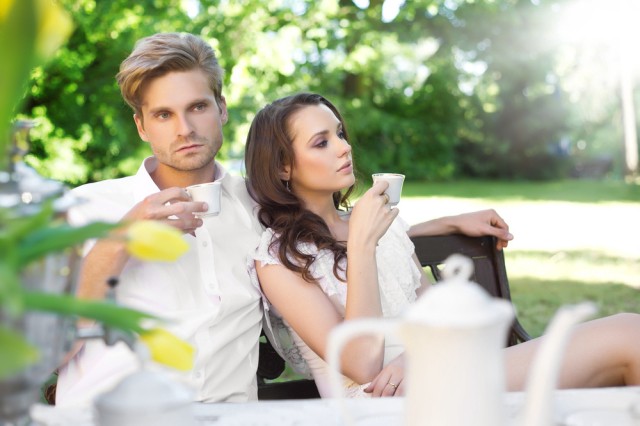
Remember a couple weeks back when tea-drinking helped prevent diabetes? Well it was all a big lie. It turns out tea is a killer… OF YOUR PROSTATE.
Men who drink lots of tea are far more likely to develop prostate cancer, researchers have warned. They found that those who drank seven or more cups a day had a 50 per cent higher risk of contracting the disease than men who had three or fewer. The warning comes after scientists at the University of Glasgow tracked the health of more than 6,000 men for four decades.
There is, however, some hopeful news buried in the report.
Researchers found that the subjects who drank the most tea were often teetotal and led healthy lifestyles. As a result, they may have been at a lower risk of death from ‘competing causes’, effectively giving them more time to develop prostate cancer, the journal Nutrition and Cancer reports.
So the takeaway here is drink as much tea as you want, but make sure you balance it out with plenty of smoking and alcohol. And whatever you do, don’t work out. You should particularly avoid Pilates, which will fuck up your back something awful. Now you know!
Photo by conrado, via Shutterstock
Paula Abdul At 50
Paula Julie Abdul turns 50 today. For comparison’s sake, her erstwhile duet partner MC Skat Kat is a strapping 23.
Twin Shadow, "Five Seconds"
So the new Twin Shadow video, which had a big public debut in Times Square yesterday, is very disappointing. The song is so good, with those amazing bell synths, stolen from that old Naked Eyes gem. I don’t know why they (George Lewis, Jr. and director Keith Musil) didn’t use better lighting in the middle of a dark forest. You can’t see anything. (Maybe it looked better on giant LED screens in Times Square?) Or, more disturbingly, why they chose to go all Braveheart on the viewer. It seems they’ve confused violence with heroism. Or even just, excitement. It’s like “the new video for Killer Mike’s Big Beast.” Another mini-movie with grand ambition, also for a terrific song, but also ruined (for me, at least, and maybe some other old people who are turning into their prudish parents) by graphic violence. I love that song, and the cinematography in the video is stunning. But I will never watch it again. Because I do not like seeing people getting their tongues cut out of their mouths. Not if it doesn’t go towards some worthy point. I’ll defend the torture scene in Reservoir Dogs til the day I die. But these videos are not that.
Dharun Ravi Walks
Dharun Ravi got out of jail this morning! (He got five days off for good behavior.) I think we can put his side of the whole sad gay-webcam-Rutgers-spying episode behind us now, please?
